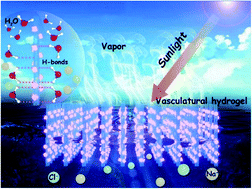A vasculatural hydrogel combined with Prussian blue for solar-driven vapor generation†
Abstract
Solar-driven clean water production presents unique merits of sustainability and environmental friendliness. Tremendous efforts have been devoted to the preparation of solar-driven vapor generators (SVGs) with timely water transport and/or excellent light-trapping properties. Herein, an efficient SVG is achieved by the combination of polyvinyl alcohol (PVA) hydrogel and Prussian blue (PB), with a unique vasculature obtained through techniques of a directional freezing and salting-out strategy. Thermodynamic calculations indicate that the water in this SVG system has lower vaporization enthalpy (1126.9 J g−1) than bulk water (2460.0 J g−1), which can be attributed to the high content of weakly hydrogen-bonded water in the PVA fibers. Moreover, both the experimental and theoretical analyses demonstrate that the vertically arranged channels existing in the SVG ensure rapid water transport (1.6 cm min−1) and light-trapping capacities. Benefitting from the above factors, the SVG exhibits a freshwater production rate of 3.44 ± 0.17 kg m−2 h−1 under 1 sun (1 kW m−2) irradiation with a photothermal conversion efficiency of up to 95% in 3.5% NaCl brine, reaching the theoretical ceiling of PVA-based materials. Additionally, it can work in practical environments for a long time without performance degradation, which is usually caused by salt scaling and biological fouling. This new kind of vasculatural hydrogel-based SVG is a competitive candidate for solar-driven clean water production, thus satisfying the growing demand for clean and safe drinking water.



 Please wait while we load your content...
Please wait while we load your content...